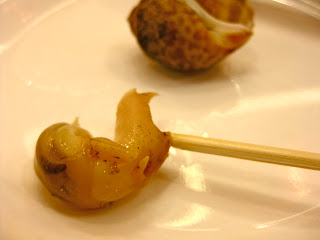WOW. I haven’t posted in a looong time. But I’m back now! So, onto food-things.
This post is all about stock.
Why stock?
I like to because it's nice to have on hand and home made always tastes so much better. The store bought stuff is fine, but I much prefer to make my own.
When the stock is done, I like to freeze them in 2-3 cup portions in Ziploc baggies. It's easy to take one or two out when you're cooking. If I use canned or boxed stock it's usually too much or too little. Portioning stock myself is nice because I can put however much I want in each bag. Some have more, some less and I can defrost exactly what I need.
I made all three stock at once. None of the stock have salt added. I like this better, because when using it later, it gives more control over the dish. Also, if you forget that the stock is salted, you may accidentally over-salt your cooking.
For stock, bones are the go-to for making delicious broth. Why bones? Because marrow! When bones are boiled you extract the flavor from deep within the bones. Because of this I like to use organic or all natural meats. Like grass-fed beef, etc. I’m usually not too strict about that, but when using bones or eating organ meats I like them… Well I guess the plainest way to put it is “untampered with.” Organs process everything coming in, filtering out chemicals and the like, so when eating liver, kidneys, etc, it’s a good practice to eat meat that was raised healthy. If you have a local butcher you like, they’ll probably sell soup bones.
This is all personal choice for me, so no biggie if you can’t get organic.
The ingredient lists go as such (I forgot to take pictures of the prep and ingredients):
For all broths
- Onions: About 1-2 onions each pot of stock, sliced
- Garlic: 2-3 cloves per pot, more if you like a stronger flavor. Minced. I have a jar I keep on hand with minced garlic, so I add a small spoonful to each pot.
- Leeks: I used 2 total. Cut them up and wash throughly to get rid of any dirt and sand. Both green and white parts used.
- Carrots: Aout 2-4 carrots each pot of stock, sliced
- Thyme: 3-4 sprigs per pot, dried would translate to about 1 tsp
For chicken stock:
- Chicken: 2 lbs, or however much fills up about half of a large pot. You can use chicken necks, backs, wingtips, yesterdays’ chicken carcass, etc… Whatever you’d like. I prefer necks and back. Bones exude flavor and not as much oil and fat on wing tips.
- Celery: 1/2 a bunch, sliced
- Chicken hearts: If you have any/can get some/want them. The hearts add a deep, meaty flavor to the broth, which I think puts a little oomph into the broth.
For Pork:
- Pork bones: 2 lbs. Pork neck bones are my go-to for stock. Very delicious. Plenty of meat to snack on afterwards or use in other things (I made meat-pies)
- Bay leaves
For Beef:
- Beef bones: 2.5 lbs, I purchased soup-bones from the butcher at North Market. Their beef is always very good quality, grass fed and very healthy.
- Tomato: 2 medium sized, roughly chopped
- Rosemary: 2-3 branches. Dried would probably be about... 1-1/2 tsp, I suppose
- Worcestershire sauce: a few shakes
When I was making stock, I did all three at once. Why? Because I just about all the stuff and I felt like it. So there will be some simultaneous/overlapping instructions in this post.
First, I got the oven going (375*F) to roast the pork and beef bones. Roasting helps develop flavor by caramelizing the meat, adding to the depth of your broth.
Pork on the left, beef on the right, before going into the oven.
I put the pork and beef bones in their own pan, glass being my preferred roasting pan. It’s easier to de-glaze and get the tasty bits out when the bones are done roasting. Shove some sliced onions in-between the bones and add some garlic here and there. These will roast along with the meats and fill the house with amazing smells.
Pop them in the oven (I could get mine side by side). Turn them once when they are sufficiently browned on one side. My pans are small, so I like to take this extra step. It’s not necessary though.
While the bones are going take a large stock pot and add a little cooking oil, onions, a little garlic, leeks, carrots and celery. Add the thyme. Cook on medium to medium high, stirring occasionally. I like to get a nice browning on the veggies.
Veggies cooked, chicken added
When the veggies are browned, add in the chicken parts and water. I fill the pot about 2/3 to 3/4 to the top. You want it sufficiently full, but not enough that it would bubble over.
Turn heat up until it boils (skimming the scum and fat off), then reduce to a simmer.
When you first add the water it will look something like the picture on the left.
The oil from cooking the veggies will float up first in very, very tiny globules.
Right: they'll begin to join together, forming larger puddles of oil
and meat/skin particles will start cooking off and coming the the surface.
Bottom: Things are coming together more, more scum has risen
and there are denser patches of collected oil.
Back to the bones.
When the bones are done, you can pull them out and put them to the side or a little while.
Pork on the left, beef right. Finished roasted bones.
Below is what is left in the pans.
Add boiling water to loosen these bits.
In the pots for the pork and beef, I cook more onions, garlic and carrots until nice and browned. For the pork, add the bay leaves and for the beef, add in the tomatoes, rosemary and a few dashes Worcestershire sauce. Take the bones out of the pans and add them to the pots. Pour out any extra fat from the pans, before pouring in some hot or boiling water. Let this sit for a few minutes, then scrape off brown bits with a wooden spoon or spatula. Pour the de-glazed contents into their respective pots.
Bring pots to a boil, then reduce to a simmer.
Throughout this entire process, make sure to be skimming off the tops of the pots. When starting to boil, a thick, bubbly brown scum will be released. Make sure to skim this off early in the process or else it will kind of coagulate, then fall back into the contents of the pot. This substance is because of impurities being released from the meats.
The top two images show the scum and oil that have collected.
The bottom left in the fat and stuff that I've skimmed off.
I use a blow of boiling water to dump the oil into.
I dip the strainer down into it,
the hot water helps loosen the oil that may
have collected and stuck to the skimmer.
Bottom right the pot looks much clearer.
Keep checking on the pots while they simmer. Fat will continue to boil off and will need to be removed every so often.
I like to cook my broths for a few hours, at the very least 4, though I very much prefer longer. Many times I will cook them the entire day. The longer they simmer, the more tasty they will get.
When you decide they are done, strain the contents of the pots and set the stock aside to cool. Reserve the bones and drained off veggies.
When the broth of cooled, I portion mine into Ziploc baggies. You can store yours however you’d like.
I will take a loaf pan and arrange 4 bags in it with the tops folded down. This helps the bag stay up and if anything drips it will already be one the inside of the bag. This saves clean up when I’m zipping the bags.
I pour about 1-1/2 or 2-1/2 cups per baggie using a measuring cup. Don’t pour from the bowl or use a ladle, both drip and spill, thus wasting the tasty stock you’ve worked so hard for. Using a measuring cup is easy, has higher sides, more control and less dripping and spilling.
As for the reserved bones, I strip the meat off and use them to make meat pies, which will be next post.
Happy stock-making!





































































